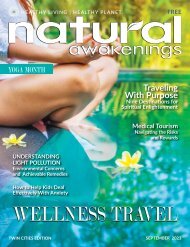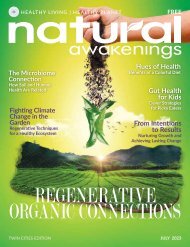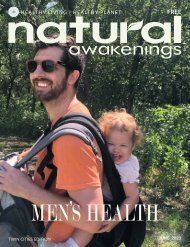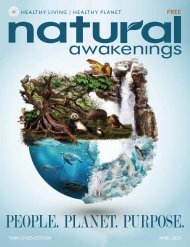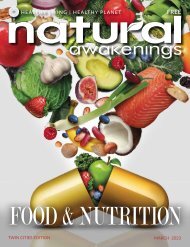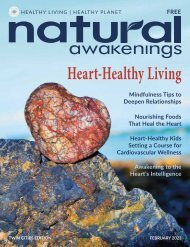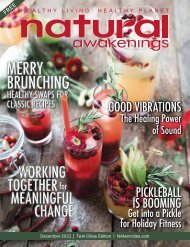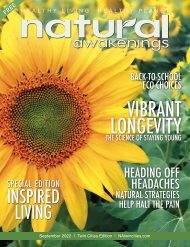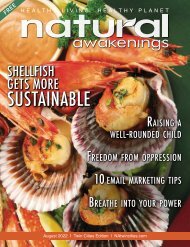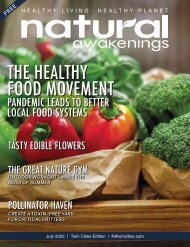Natural Awakenings Twin Cities January 2022
Read the January 2022 edition of Natural Awakenings Twin Cities magazine. This is our annual Directory Issue which is focused on Annual Health and Wellness Guide. This month we feature articles on breast cancer causes, the cannabis industry, healthy coffee alternatives, wellness trends for 2022 and so much more! Be sure to check out our local content including News Briefs announcements, Community Resource Guide with providers throughout the metro who can meet your individual wellness needs, and all the happenings in the Calendar of Events. There is additional online-only content that can be found at NATwinCities.com. While you are there, be sure to sign up for our Newsletter and Digital Magazine and continue your reading with our archived articles from local experts.
Read the January 2022 edition of Natural Awakenings Twin Cities magazine. This is our annual Directory Issue which is focused on Annual Health and Wellness Guide. This month we feature articles on breast cancer causes, the cannabis industry, healthy coffee alternatives, wellness trends for 2022 and so much more!
Be sure to check out our local content including News Briefs announcements, Community Resource Guide with providers throughout the metro who can meet your individual wellness needs, and all the happenings in the Calendar of Events. There is additional online-only content that can be found at NATwinCities.com.
While you are there, be sure to sign up for our Newsletter and Digital Magazine and continue your reading with our archived articles from local experts.
You also want an ePaper? Increase the reach of your titles
YUMPU automatically turns print PDFs into web optimized ePapers that Google loves.
iStock.com image<br />
Cloudy Skies<br />
It’s Not the Heat, It’s the Humidity<br />
For more than 20 years, a large part of the tropical North Atlantic<br />
Ocean has been warmer than usual, causing more moisture to evaporate<br />
and fueling strong hurricanes. The amount of vapor in the atmosphere<br />
has increased about 4 percent since the 1990s, and a wetter<br />
atmosphere provides extra energy and moisture for storms of all<br />
kinds. According to data from the Bulletin of the American Meteorological<br />
Society, midlatitude storms are feeding on the atmosphere’s extra<br />
vapor too, creating more precipitation. Although carbon dioxide is the<br />
more recognized problem, water vapor is a more impactful greenhouse<br />
gas by far because it absorbs a greater amount of the infrared energy<br />
radiated off the planet’s surface than other greenhouse gases, thus<br />
trapping more heat.<br />
A doubling of atmospheric carbon dioxide concentrations alone<br />
would warm the globe approximately one degree Celsius, but feedback<br />
loops make the temperature rise twice as much. Even though disappearing<br />
sea ice may be dramatic, the extra vapor causes evaporation,<br />
which traps heat and creates even more warming, representing the<br />
strongest feedback loop in the climate system. We can reduce the effect<br />
indirectly by reducing the warming caused by emissions of carbon<br />
dioxide and methane, as well as propagating trees that absorb carbon<br />
from the air.<br />
Silver Fillings:<br />
Just ugly?<br />
Or harmful too?<br />
This is a picture<br />
of a “Silver”<br />
or “Amalgam”<br />
filling. It is 50 -<br />
52% MERCURY!<br />
If the mercury in<br />
this filling were spilled in a school,<br />
it would be evacuated....<br />
peter waters/AdobeStock.com<br />
Hello Honey<br />
Honeybees Dodge Parasites<br />
with Social Distancing<br />
A study by University College London<br />
and the University of Sassari (Italy)<br />
published in Science Advances shows<br />
that honeybee colonies respond to<br />
infestation from harmful mites<br />
by varying space and interaction<br />
in the hive to increase<br />
social distance between the<br />
younger and older insects. Co-author Dr. Alessandro Cini says,<br />
“Honeybees are a social animal, as they benefit from dividing up responsibilities<br />
and interactions such as mutual grooming, but when those social<br />
activities can increase the risk of infection, the bees appear to have evolved<br />
to balance the risks and benefits by adopting social distancing.”<br />
The study assessed the presence of the ectoparasite mite Varroa destructor,<br />
which causes harmful effects at the colony level, including virus transmission.<br />
Lead author Dr. Michelina Pusceddu says, “Their ability to adapt their<br />
social structure and reduce contact between individuals in response to a<br />
disease threat allows them to maximize the benefits of social interactions<br />
where possible and to minimize the risk of infectious disease when needed.<br />
Honeybee colonies provide an ideal model for studying social distancing and<br />
for fully understanding the value and effectiveness of this behavior.”<br />
This is a picture<br />
of a “light cured”<br />
composite filling.<br />
They can last as<br />
long or longer<br />
than mercury<br />
fillings with no danger of releasing<br />
harmful heavy metals.<br />
As noted on Dr. Mercola,<br />
Dr. Oz, and 60 Minutes...<br />
Mercury fillings may have a<br />
significant negative impact on your<br />
overall health.<br />
Make <strong>2022</strong> 2017 YOUR year<br />
for healthy choices!<br />
Dr. Madelyn Pearson is the<br />
current president of the<br />
Holistic Dental Association and<br />
has advanced training in safe<br />
mercury removal.<br />
Call or visit our website for<br />
more info: (651) 483-9800<br />
www.<strong>Natural</strong>SmilesDental.com<br />
<strong>January</strong> <strong>2022</strong><br />
11



